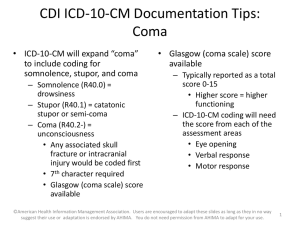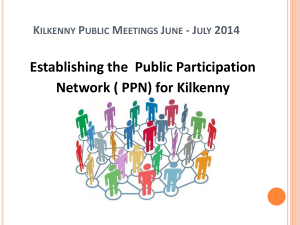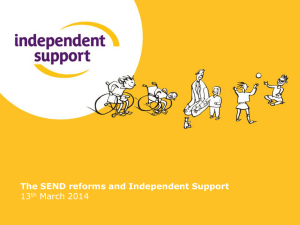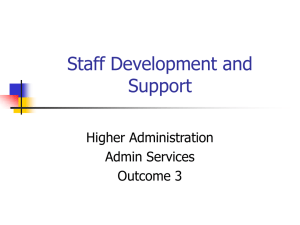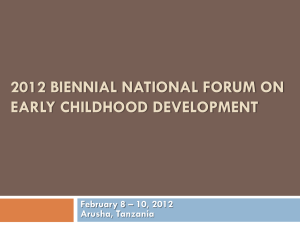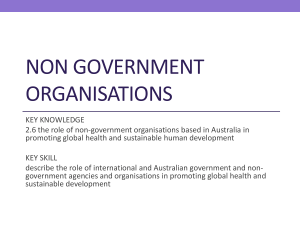PPN Presentation August 2014 Roscommon
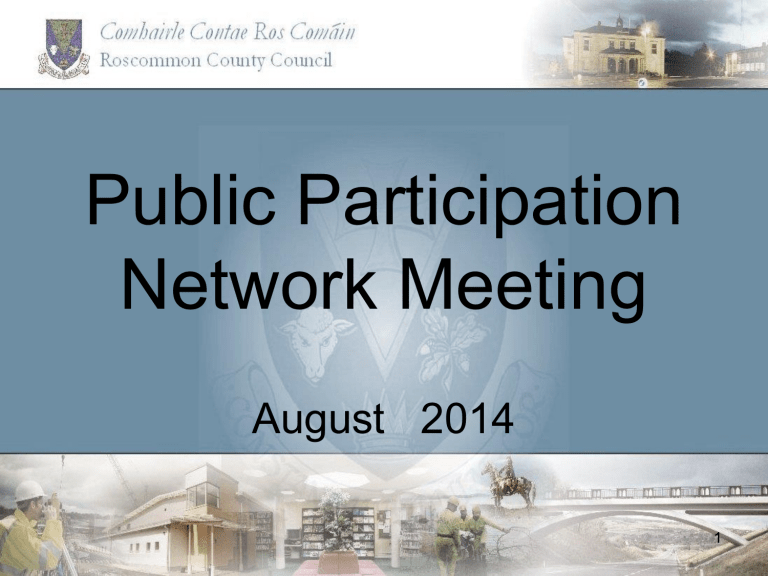
Public Participation
Network Meeting
August 2014
1
Public Participation Network
• Section 46 of the Local Government Reform Act 2014 enables local authorities to take all appropriate steps to consult with and promote effective participation of local communities in local government.
• The Working Group on Citizen Engagement was set up in September 2013 under the chairmanship of Fr. Sean Healy. The role of the Group was to make recommendations on more extensive and diverse input by citizens into the decision making at local government level.
• PPN structure to be set up initially at County level on an administrative basis.
•
Final Guidelines due September 2014.
• Regulations due December 2014.
2
Framework for Public Engagement and Participation
• The PPN will be the main link through which the local authority connects with the community, voluntary and environmental sectors without prejudice to other consultation processes.
• Aim of PPN structures and processes is to facilitate and enable the public and the organisations to articulate a diverse range of views and interests within the local government system, not to reduce or homogenise this diversity.
• The Network:
• Facilitates participation and representation of communities on decision making bodies
• Strengthens capacity of communities and groups to contribute positively to the community in which they reside/participate
•
Provides information relevant to the environmental, social inclusion and voluntary sector and acts as a hub around which information is distributed and received.
3
The Role of the Network is;
• To contribute to the local authority’s development for the County/City a vision for the well-being of this and future generations.
• to identify issues of collective concern and work to influence policy locally in relation to these issues.
• to actively support inclusion of socially excluded groups, communities experiencing high levels of poverty and communities experiencing discrimination
• to encourage and enable public participation in local decision making and planning of services.
• to facilitate the selection of participants from the environmental, social inclusion and voluntary sectors onto city/county decision making bodies.
• to support the individual members of the Public Participation Network so that:
– They can develop their capacity and do their work more effectively.
– They can participate effectively in the Public Participation Network activities.
– They are included and their voices and concerns are heard.
4
The Public Participation Network will
•
Implement and abide by good governance structures. One way of doing this would be by adopting the ‘Governance Code for
Community, Voluntary and Charitable Organisations’.
• Work in an inclusive, respectful, transparent and collaborative manner.
• Act as the vehicle to gather feedback and input into policies and plans being developed by local authorities, reflecting both areas of disagreement and, where there is no consensus, the range of views.
5
Outline of structure
• The Public Participation Network (PPN) will be organised:
•
At County/City level
• At Municipal District level
• Each PPN will have:
•
A County/City Plenary at County/City level which deals with county/city level issues
• A Municipal District Plenary in each Municipal District which deals with issues at a municipal level
•
Linkage Groups which deal with specific issues
• A secretariat at county level that is a facilitation and communication mechanism.
6
Municipal District PPN
• Under the Local Government Reform Act 2014, each county is divided into Municipal Districts. (3 in
Roscommon)
• Each Municipal District will have a Public Participation Network (PPN). This is made up of community, voluntary and environmental organisations within the Municipal District. These organisations work together on agreed objectives based on promoting the well-being of this and future generations.
• Municipal District Plenary
• The Plenary is the ruling body of the Municipal District PPN and is made up of all registered community, environmental and voluntary organisations in the District.
• Each Member Organisation will have one vote. They may select two people to represent them on Plenary of the Municipal District PPN. One of these people will be the main Representative and the other the
Alternate.
• The plenary of each Municipal District PPN will meet formally at least twice a year. The initial meeting in year one will be convened by the County/City Council after which the Municipal District PPN makes its own arrangements.
• The Plenary of each Municipal District PPN nominates one person to the Secretariat for the County/City
PPN.
• Member organisations of the Municipal District PPN may also be members of the City/County PPN.
7
County PPN
• All registered organisations in the County/City are members of the County/City PPN. The PPN will be the main channel through which people will be selected to participate in various processes of the County/City Councils and their Boards/Committees.
•
Participants will be chosen by the PPN and should not be rejected by the County Council or any of its structures.
Likewise, the Council or its structures should not bypass the PPN in choosing representatives from the social inclusion, environmental or voluntary sectors to sit on any of its Boards/Committees.
•
County Plenary
• At a county level the Plenary is the ruling body of the PPN
• Member organisations are represented on the Plenary of the County/City PPN.
• The County/City PPN Plenary will meet formally at least twice a year. The first meeting in year 1 will be organised by the Local Authority after which the County/City PPN Plenary will make its own arrangements.
• Each Member Organisation will have one vote. They may select two people to represent them on the Plenary. One of these people will be the main Representative and the other the Alternate.
• A Plenary Meeting shall be deemed a valid meeting if at least 15% of the Member Organisations are represented and also only if at least 4 of those present are members of the Secretariat. There must also be an automatic and guaranteed 21 days’ notice of the meeting.
8
Secretariat
• Each City/County PPN will have a Secretariat whose role is to ;
• Facilitate the implementation of the decisions of the Plenary
• Ensure the proper functioning of the PPN in between Plenary meetings
• Coordinate activities of the PPN
• Communicate extensively and regularly with all PPN members and in this process disseminate information concerning all PPN activities as widely as possible
•
Manage the resource worker who will be provided to PPN at a county level to enable them in delivering their objectives
• The Secretariat will meet at least four times a year.
• The Secretariat will be made up of:
– one representative nominated from each of the Municipal District PPNs
– An equal number of representatives from each of the electoral colleges of the PPN, i.e. Community, Social Inclusion, and Environment. The minimum should be two from each.
9
Linkage Groups
The Linkage Group mechanism is central to ensuring that:
•
All member organisations are enabled to participate in shaping the decisions that affect them that are being developed by any structure of the County/City Council.
• All member organisations play a direct role in choosing their participants in County/City Council structures addressing particular issues.
•
The views of all those involved will be communicated within the relevant County/City structure.
•
All member organisations will be fully up to date with developments in all of these County/City structures.
•
When the County/City Council has public participant seats to fill on any of its committees/structures it will notify the
PPN Secretariat and ask that the representatives to fill these seats be chosen by the PPN.
• The Secretariat will then
– Notify ALL member organisations in the County/City of this situation, and
– Arrange a time and place for a meeting of all those organisations with an interest/involvement in the issue(s) being addressed by the particular body or, in the case of places representing particular interests of communities, those organisations which fit the relevant criteria.
• This group will constitute a PPN ‘Linkage Group’ for this particular body and the topic(s) being addressed.
10
Linkage Groups (continued)
• The Linkage Group will choose their representative(s) for the body.
• The person(s) chosen to represent the PPN in such bodies will meet their Linkage Group regularly.
• The Linkage Group should operate as their reference group on the issues arising.
• They will report back to the Linkage Group after every meeting.
• They will take direction from the Linkage Group on the positions they are to take on particular issues.
• Each representative taking up such a position for the PPN must
– Represent the views of all the members of the Linkage Group and not just those of their own organisation.
– Abide by the communications protocols set out above.
11
Electoral Colleges
•
Member Organisations when joining the PPN at a county level must opt to be a part of one of three electoral colleges within the PPN:
– Environment
– Social Inclusion
– Voluntary
• To join the environment Electoral College an organisation’s primary objectives and activities must be environmental (i.e. ecological) protection and/or environmental sustainability. Membership of this Electoral College will be validated by the Environmental Pillar at a national level.
• To join the Social Inclusion Electoral College an organisation’s primary objectives and activities must focus on social inclusion / social justice / equality.
• Organisations whose primary objectives are other than those listed above will be members of the Voluntary
Electoral College.
•
Each of these three Electoral Colleges
– Chooses an equal number of people (but not less than two) to represent them on the PPN Secretariat.
– Elects members from among their own college members to represent them on the County’s Local Community Development
Committee.
– In this respect, 5 members are to be nominated to the LCDC from the PPN (two from the Community and Voluntary
College, two from the Social Inclusion College and one from the Environment College).
12
County Public Participation Network (PPN)
Environmental
Electoral College
Min 2
1
Social Inclusion
Electoral College
Min 2
County PPN Secretariat
1
Municipal
District PPN
Municipal
District PPN
Community
Electoral College
Min 2
Resource
Worker
1
Municipal
District PPN
13
PPN Representation
•Local Community Development Committee
(LCDC)
•Strategic Policy Committees (SPC)
Local Community Dev. Committee
Board of 17 Members
• 5 Public Participation Network Representatives
• 1 Local Community Development Rep.
• 1 Farming and Agriculture Rep.
• 1 Trade Union Rep.
• 1 Business Representative Rep.
• 5 Local Govn. 1 CEO + 3 Co. Cllrs + 1 Head of LEO
• 3 State Agencies
» Teagasc
» Galway & Ros Ed & Training Board
» Dept. of Social Protection
Choosing of PPN Representatives to any body
• The following criteria will apply in making the decision about who to nominate:
– The track record of the nominee in working on the issue that is the focus for the representative forum.
– The ability of the nominee to make an effective contribution.
– The participation of people experiencing the problem/issue to be addressed at the representative forum.
– Whether the problem/issue to be addressed at the forum is a ‘core issue’ for the PPN member.
– As far as possible ensuring fair distribution of positions across geographical areas.
– As far as possible ensuring gender balance.
– A commitment from the person(s) to operate the linkage arrangements set out below.
•
Representing the PPN
•
The nominees are required to represent the PPN and are accountable to the PPN membership. They are not representing their own organisation.
• Specifically the role of the representative is to
– Bring issues of relevance from the body that chose them to the policy making arena.
– Give feedback to their Linkage Group, Electoral College and/or Plenary as appropriate on the outcomes of the policy meetings and the issues being raised.
16
Benefits to groups in joining a Network
• Only those groups who are members of the Network may nominate individuals to sit on Boards/Committees as
Network participants/representatives
•
Receipt of regular information which highlights and promotes the work of the Network and the activities of its members
• Receipt of information on opportunities to learn about and feed into policy and plans that may be relevant to the group
•
May be part of a Linkage Group which meets directly and regularly with those representing the PPN on various
County Boards/Committees dealing with issues of concern to the particular member organisation.
• Receipt of and submission of information / being part of a communications system managed by the Network
• Vote as an organisation to elect members on the countywide Secretariat
• Participate in training courses and workshops organised by the Network that support the development of the sectors involved and their representation on decision making bodies
•
Engage in the wide variety of activities organised by the Network
•
Can be elected on to policy making bodies in the city/county.
•
Member groups can be part of a collective voice.
17
